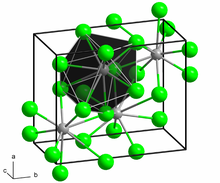Loading AI tools
Chemical compound From Wikipedia, the free encyclopedia
Europium(II) chloride is an inorganic compound with a chemical formula EuCl2. When it is irradiated by ultraviolet light, it has bright blue fluorescence.[3]
 | |
 | |
| Names | |
|---|---|
| Other names
Europium dichloride | |
| Identifiers | |
| |
3D model (JSmol) |
|
| ChemSpider | |
| ECHA InfoCard | 100.033.973 |
| EC Number |
|
PubChem CID |
|
CompTox Dashboard (EPA) |
|
| |
| |
| Properties | |
| Cl2Eu | |
| Molar mass | 222.86 g·mol−1 |
| Appearance | white solid |
| Density | 4.86 g·cm−3[1] |
| Melting point | 738 °C (1,011 K)[2] |
| Boiling point | 2,190 °C (2,460 K)[2] |
| Related compounds | |
Other anions |
europium difluoride europium dibromide europium diiodide |
Other cations |
samarium dichloride thulium dichloride |
Related compounds |
europium trichloride |
Except where otherwise noted, data are given for materials in their standard state (at 25 °C [77 °F], 100 kPa).
| |
Europium dichloride can be produced by reducing europium trichloride with hydrogen gas at high temperature:[4]
If dry europium trichloride reacts with lithium borohydride in THF, it can also produce europium dichloride:[5]
Europium dichloride can form yellow ammonia complexes:EuCl2•8NH3, and can dissolve to pale yellowish EuCl2•NH3.[4] Europium dichloride can react with europium hydride at 120-bar H2, producing EuClH that fluoresces green.[6]
Seamless Wikipedia browsing. On steroids.
Every time you click a link to Wikipedia, Wiktionary or Wikiquote in your browser's search results, it will show the modern Wikiwand interface.
Wikiwand extension is a five stars, simple, with minimum permission required to keep your browsing private, safe and transparent.